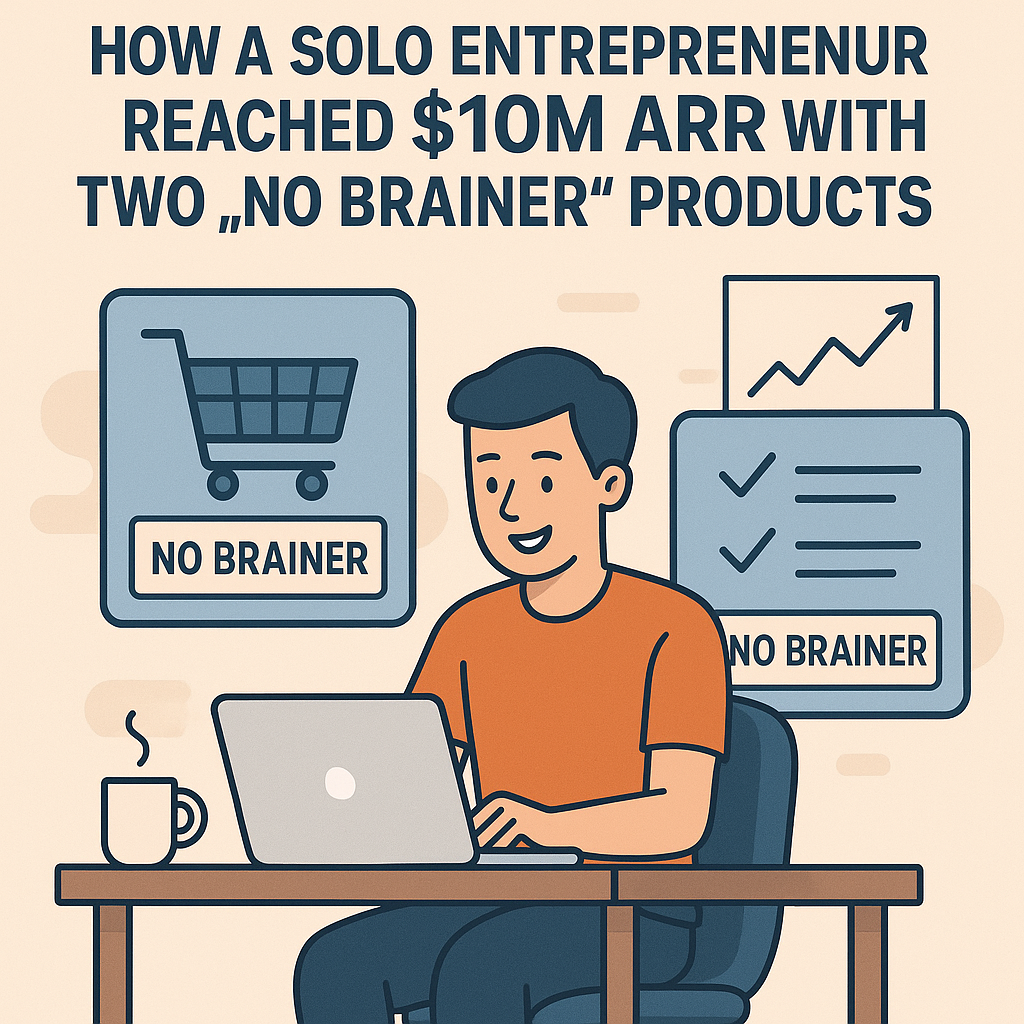Imagine achieving a staggering $10 million annual recurring revenue (ARR) with just two products. Sounds like a dream, right?
But for one solo entrepreneur, it became a reality. You’re probably wondering how this was possible and what secrets led to such remarkable success. You’re not alone. Many entrepreneurs, like yourself, are eager to unlock the mysteries behind transformative business growth.
This blog post will reveal the strategies and insights that propelled a solo entrepreneur to such impressive heights. You’ll discover how simple, no-brainer products can be the key to reaching your financial goals. As you read on, you’ll find that these tactics aren’t just for the select few—they’re accessible to anyone willing to embrace innovative thinking and strategic planning. So, are you ready to explore the possibilities and see how you can apply these principles to your own entrepreneurial journey? Let’s dive in and uncover the secrets that could change everything for you.
Table of Contents
ToggleInception of the Idea
The journey of a solo entrepreneur reaching 10M ARR with two products is inspiring. Behind every successful venture lies a unique inception story. Understanding the genesis of ideas is crucial for aspiring entrepreneurs.
Understanding Market Needs
The entrepreneur began by analyzing market gaps. Identifying underserved areas was key. This required thorough research and observation. Listening to consumer pain points sparked creative solutions. Recognizing what people lacked guided product development.
Brainstorming Sessions
Ideas flowed during dedicated brainstorming periods. The entrepreneur used mind maps to visualize concepts. This process encouraged creativity and innovation. Diverse ideas were considered before narrowing them down. Collaboration with peers provided fresh perspectives.
Feasibility Studies
Testing the viability of ideas is essential. The entrepreneur conducted feasibility studies early on. These studies assessed potential risks and rewards. Resources and market acceptance were evaluated. This ensured ideas were practical and executable.
Crafting a Unique Value Proposition
Creating a compelling value proposition was fundamental. The entrepreneur focused on offering something distinct. This involved highlighting benefits over features. The aim was to solve specific problems effectively. A clear value proposition attracted initial interest.
Prototyping and Feedback
Developing prototypes helped in refining ideas. Feedback from potential users was invaluable. It guided improvements and adjustments. The entrepreneur embraced criticism constructively. Iterative testing shaped the final products.
Identifying Market Needs
Identifying market needs is the secret ingredient to any successful business recipe. It’s about understanding what people truly want and delivering it in a way that makes their lives better. For a solo entrepreneur aiming for the stars with two simple yet powerful products, honing in on market needs was the turning point.
Listening to Your Audience
Pay attention to what your potential customers are saying. Are they expressing frustration about a lack of solutions? Is there a recurring problem they’re facing? When the solo entrepreneur began his journey, he spent countless hours engaging with his audience through social media and forums. This wasn’t just about gathering feedback; it was about understanding the pain points that needed urgent addressing.
Spotting Gaps in the Market
Look for what’s missing in the current market offerings. Are there products that are too complex or expensive? Can they be simplified? The entrepreneur noticed that existing solutions were either too convoluted or overpriced. This led him to identify an opportunity to create no-brainer products that were accessible and easy to use.
Finding Patterns in Customer Behavior
Identify trends in how people are interacting with products. Are they using them in unintended ways? What features are they ignoring? Observing these patterns gave the entrepreneur valuable insights. It allowed him to refine his products, ensuring they met actual user needs rather than assumed ones.
Testing and Adapting
Constantly test your ideas and adapt as needed. Are your assumptions correct? Is the feedback aligning with your vision? The solo entrepreneur didn’t shy away from testing prototypes and iterating based on real-world feedback. This adaptive approach ensured his products were always aligned with market demands.
Engaging with Your Community
Build relationships with your community. Are you fostering trust and loyalty? Are you showing genuine interest in their needs? The entrepreneur’s success was partly due to his genuine engagement with his community. By being accessible and responsive, he built a loyal customer base that championed his products.
Have you ever paused to ask yourself what the market truly needs? The answer might surprise you. It’s often simpler than you think, waiting to be discovered by those who dare to listen closely.
Crafting the No Brainer Products
A solo entrepreneur reached 10M ARR by crafting two simple, effective products. These “no brainer” solutions met clear needs and captured the market quickly. Focused innovation and understanding customer needs paved the way for this remarkable success.
Crafting the no brainer products was the turning point for this solo entrepreneur. Two simple products brought clarity and focus. They resonated with customers and simplified their choices. The strategy was clear: create products that are easy to understand and solve real problems. Customers should instantly see their value. Here’s how this entrepreneur did it.
Product Simplicity
Simplicity was key to success. The products were stripped of complexity. Each feature had a clear purpose. This approach ensured customers knew what they were buying. Confusion was eliminated. Customers appreciated straightforward solutions. No frills, no fuss. Just products that did what they promised. Simple products make decisions easy.
Value Proposition
The value proposition spoke directly to the customers. It addressed their needs and concerns. No technical jargon, just clear benefits. Customers could immediately see how the products added value. This clarity built trust. A strong value proposition removes doubt. It reassures customers they are making a wise choice. The entrepreneur crafted messages that were direct and impactful.
Building a Lean Operation
The journey of a solo entrepreneur reaching a remarkable 10M ARR is nothing short of inspiring. It’s not just about having brilliant ideas; it’s also about building a lean operation that maximizes resources and minimizes waste. How do you create such an efficient system? Let’s explore some practical strategies that can help you streamline your business operations.
Cost-effective Strategies
Every penny counts when you’re running a business solo. It’s essential to identify areas where you can save money without compromising quality. Start by evaluating your expenditures. Are there subscriptions you rarely use? Cancel them.
Consider negotiating better rates with your suppliers. Sometimes, a simple conversation can lead to substantial savings. Focus on spending money where it truly matters, like enhancing product quality or customer experience.
Investing in cost-effective marketing strategies can also be a game changer. Social media platforms offer targeted advertising at a fraction of traditional costs. Engage directly with your audience and turn followers into customers without draining your budget.
Outsourcing and Automation
Running a one-person operation doesn’t mean you have to do everything yourself. Outsourcing is a powerful tool for accessing expertise without hiring full-time staff. Identify tasks that consume your time but don’t generate revenue. Could someone else do them better or quicker?
Platforms like Upwork or Fiverr are excellent for finding skilled freelancers. You could outsource bookkeeping, graphic design, or even customer service. This frees up your time to focus on core business functions.
Automation is another weapon in your arsenal. Use tools that automate repetitive tasks. Email marketing, inventory management, and social media scheduling can all be automated, reducing manual work and increasing efficiency.
What tasks in your daily operations could be automated? Consider leveraging software that offers integration with your current systems. This will help streamline processes and eliminate errors.
Building a lean operation is about smart choices and strategic planning. As a solo entrepreneur, you have the agility to adapt quickly. Use these strategies to simplify your processes and propel your business towards success. Remember, the goal is to work smarter, not harder. What’s your first step towards building a lean operation?
Marketing and Growth Strategies
Marketing and growth are the lifelines for any solo entrepreneur aiming for success. With the right strategies, even a one-person business can reach impressive heights. Imagine hitting a staggering $10M ARR with just two products. Sounds impossible? It’s not. The key is knowing where to focus your energy and resources. Let’s dive into some marketing and growth strategies that can make this dream a reality.
Leveraging Social Media
Social media is more than just a platform for sharing memes or keeping up with friends. It’s a powerful tool for reaching your target audience and driving sales. Start by identifying where your audience spends most of their time. Is it Instagram, LinkedIn, or TikTok?
Create engaging content that resonates with your audience. Share behind-the-scenes moments, customer testimonials, or even product demos. Use polls and questions to involve your audience directly.
Consistency is key. Regularly post content that aligns with your brand and values. Engage with your followers by responding to comments and messages promptly. This builds trust and loyalty.
Word-of-mouth Marketing
Imagine your product is so good that customers can’t help but talk about it. This is the power of word-of-mouth marketing. Encourage customers to share their experiences through reviews and testimonials.
Offer incentives like discounts or freebies for referrals. This not only rewards loyal customers but also attracts new ones. Personalize the experience by addressing customers by name and tailoring recommendations.
Think about this: Have you ever tried a product just because someone you trust recommended it? Use this insight to build a community of brand advocates who will naturally spread the word.
Are you ready to take your solo venture to new heights? With these strategies, the journey to $10M ARR becomes not just possible but highly achievable.

Credit: redcircle.com
Customer Retention Techniques
Discover how a solo entrepreneur achieved $10M ARR with two simple products. Effective customer retention techniques played a key role. Building strong relationships and offering consistent value kept customers returning, driving sustainable growth.
In the journey to a 10M ARR, customer retention stands crucial. Keeping customers happy ensures they continue using your products. This solo entrepreneur mastered techniques to keep customers loyal. Let’s explore the ways they achieved this.
Personalized Customer Service
Customers appreciate when they feel valued. Offering personalized customer service builds trust. This entrepreneur used data to understand customer needs. By addressing specific issues, they created lasting relationships. Quick responses made customers feel heard and important. Personal touches, like using first names, added warmth to interactions. These small gestures enhanced customer satisfaction significantly.
Community Engagement
Building a community around products creates loyal customers. This entrepreneur fostered a sense of belonging. They encouraged customers to share feedback and ideas. Engaging with customers on social media platforms built a strong network. Hosting online events and webinars kept customers informed and connected. This active engagement turned customers into brand advocates. They felt part of something bigger, which increased loyalty. By implementing these techniques, the entrepreneur maintained a strong customer base. Their focus on retention played a key role in reaching their financial goals.
Scaling for Success
Reaching a 10M ARR as a solo entrepreneur is a big achievement. It requires strategic planning and the ability to adapt. The journey involves understanding market dynamics and product evolution. This is where scaling for success becomes essential. A well-thought-out strategy can help meet growing demands and sustain growth. Let’s explore how adaptability and expansion played a role in this success story.
Adapting to Market Changes
The market constantly changes, demanding entrepreneurs to stay alert. Observing trends helps in foreseeing potential shifts. Being proactive is crucial for maintaining relevance. This solo entrepreneur keenly monitored industry trends. They adjusted their products to meet evolving customer needs. Quick adaptations minimized risks and maximized opportunities. Staying flexible allowed them to stay ahead of competitors.
Expanding Product Lines
To grow, expanding product lines can be a smart move. This entrepreneur started with two no-brainer products. As demand increased, they explored related products. Introducing new offerings met diverse customer needs. It also tapped into broader market segments. Careful research ensured that each product added value. This strategic expansion contributed significantly to reaching 10M ARR.

Credit: medium.com
Lessons Learned
Reaching a $10M ARR as a solo entrepreneur is no small feat. This journey taught many lessons. Each challenge brought valuable insights. These insights shaped future decisions and strategies.
Overcoming Challenges
Every entrepreneur faces challenges. Some are financial, others operational. This solo entrepreneur faced both. Initially, managing everything alone felt overwhelming. The workload was intense. Prioritizing tasks became crucial. This ensured focus on core activities.
Cash flow was another challenge. Investing in growth while maintaining stability required careful planning. The solution? Streamlining expenses and maximizing returns. This balanced approach helped maintain a steady cash flow.
Future Vision
With the foundation set, the future looks promising. Diversifying products is a priority. Expanding the product line can increase market reach. The goal is to offer more value to customers.
Another focus is enhancing customer experience. Happy customers lead to growth. Feedback loops help understand user needs. This approach ensures products evolve with customer expectations.
Scaling operations is also on the radar. Efficient systems can support increased demand. Automation plays a key role here. It allows handling more tasks with less effort. This prepares the business for future expansion.

Credit: www.linkedin.com
Frequently Asked Questions
How Do Entrepreneurs Run Multiple Businesses?
Entrepreneurs run multiple businesses by prioritizing tasks, delegating responsibilities, and maintaining strong organizational skills. They use efficient time management and leverage technology to streamline operations. Building a reliable team helps ensure smooth processes across ventures. Regularly assessing business performance allows them to adapt strategies and achieve growth.
What Is the Difference Between an Entrepreneur and a Solopreneur?
An entrepreneur builds and manages a business with a team. A solopreneur runs a business alone, handling all tasks independently. Entrepreneurs aim for growth, often seeking external funding. Solopreneurs focus on personal fulfillment, typically with limited scalability. Both drive innovation and create value in their respective fields.
What Do Entrepreneurs Do When They Run Their Business Mention Any Two?
Entrepreneurs manage daily operations and make strategic decisions to drive business growth. They also foster innovation and motivate their teams.
Are Entrepreneurs People Who Start New Businesses?
Yes, entrepreneurs are individuals who start new businesses. They identify opportunities and create solutions. Entrepreneurs take risks to innovate and drive economic growth. Their ventures often introduce new products or services to the market. They play a crucial role in job creation and advancing industries.
Conclusion
Reaching 10M ARR as a solo entrepreneur is inspiring. It shows dedication. Simple products can lead to big success. Focus on solving real problems. Keep your business model clear and concise. This approach worked wonders here. Consistency and determination are key.
Stay persistent and keep learning. Listening to customer feedback is crucial. It helps refine your products. Remember, success comes with patience and hard work. Anyone can achieve their goals with the right mindset. Keep pushing forward, and you’ll find success too.




